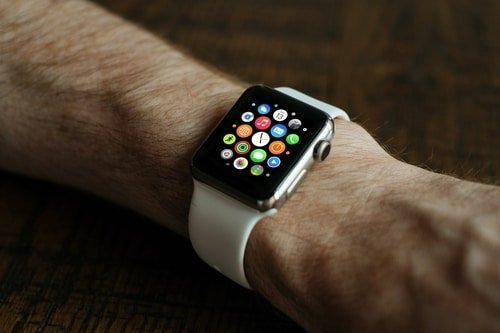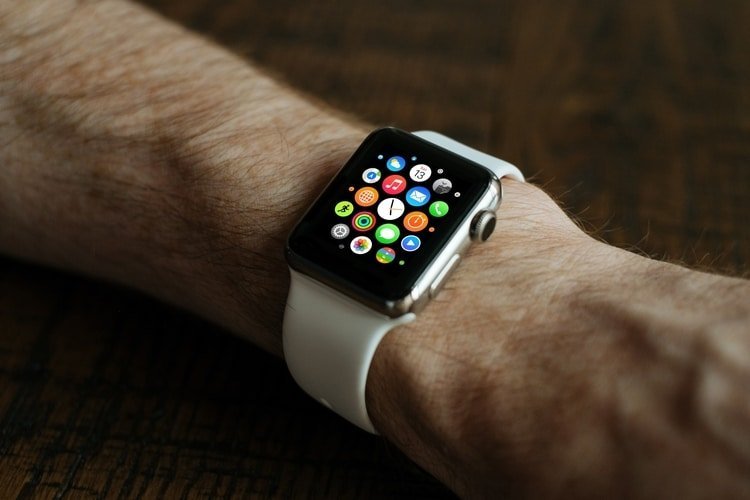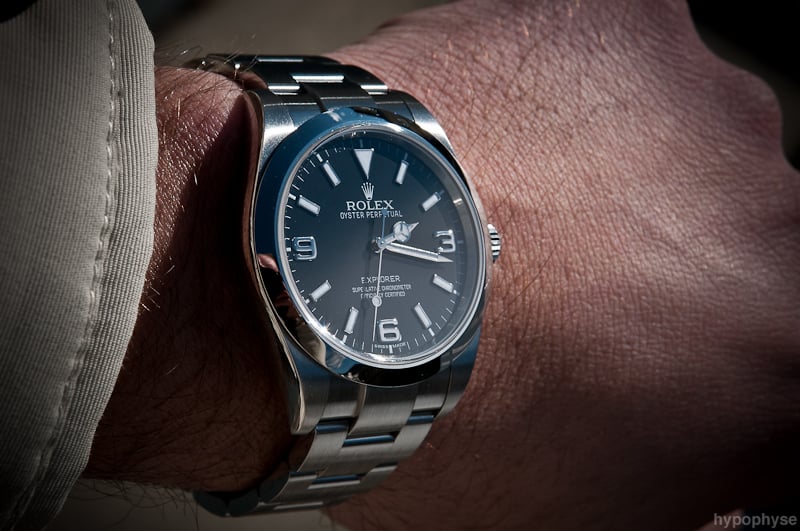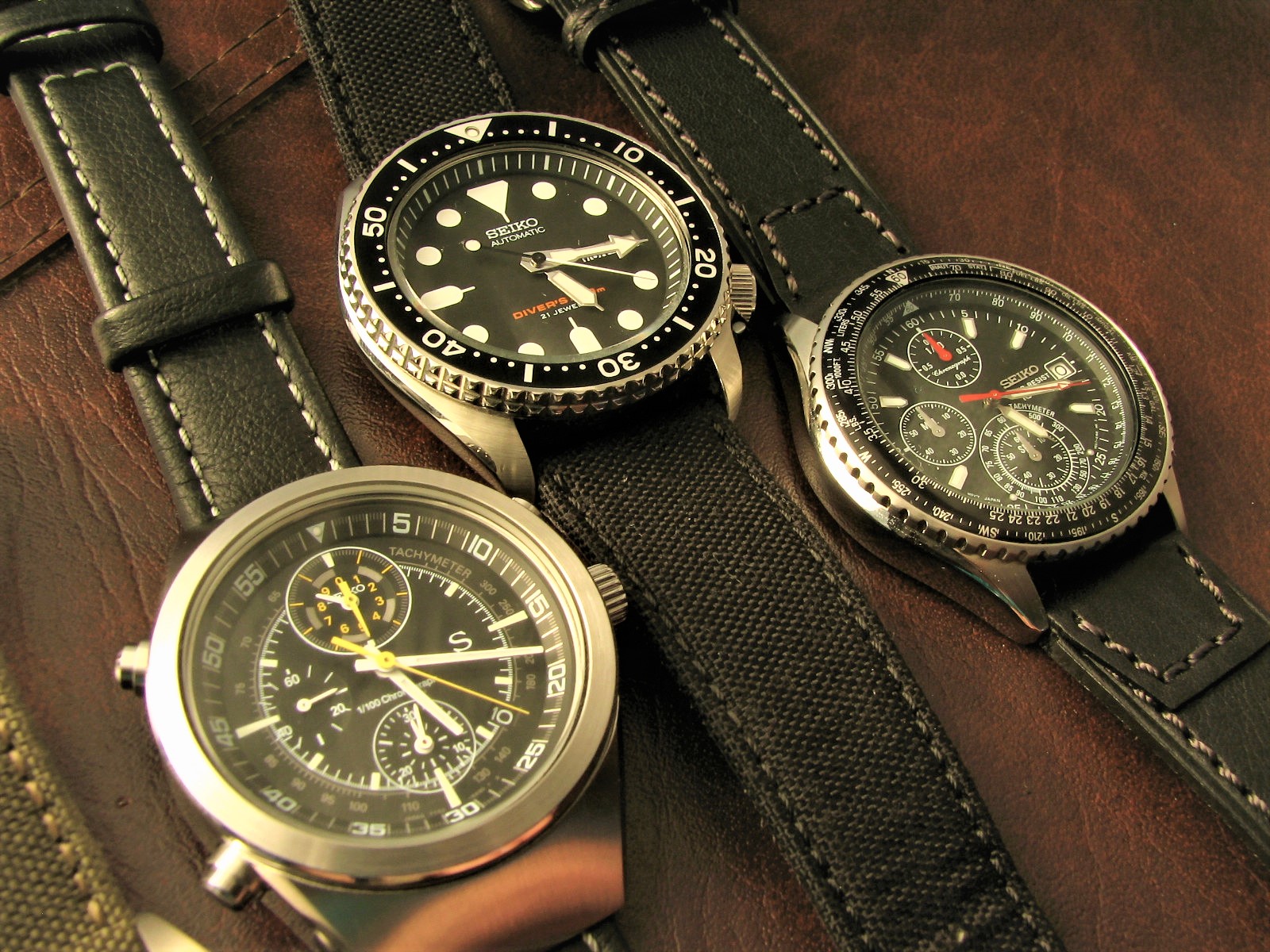Love or hate their products, Apple is unquestionably the king of hype. Ever since the late Steve Jobs took the stage in 2001 and announced the iPod, all other companies have been playing catch-up, at least in terms of expectations. Apple may no longer be a leader in innovation, but they still know how to stir up a frenzy.

Like everything else Apple creates, the Apple Watch has its fans and its detractors. Originally released in 2015, Apple’s version of the smartwatch is currently in its fourth iteration. Each version has upped the functionality and relevance. Similar to the iPhone, though, the rapid obsolescence of older versions can be frustrating for users.
In this article, we’ll look at what the different versions of the Apple Watch got right, and some of the areas in which they need to improve. But first, we should start at the beginning.
Table of Contents
A brief history of Apple
For much of its history, Apple Inc. (formerly Apple Computer, Inc.) was steered by co-founder Steve Jobs. The company came into existence in 1976 when Jobs, Steve Wozniak and Ronald Wayne joined forces to create the Apple 1 personal computer.
The company found impressive, if inconsistent success in the 80s, but as Apple grew, so did the structures of power. In 1985, in the midst of a power struggle, Jobs left the company. He would go on to found a rival computer company, NeXT, which would ultimately be the precursor to Apple’s current operating system. With Apple faltering in the 90s, Jobs returned to the company in 1997.
Jobs’ return led to a restructured company and a new focus on innovation. In 2001, Jobs famously announced the iPod, an MP3 player that helped transform the music industry. In 2007, Jobs once again disrupted the tech world when he presented the first iPhone at the Macworld Conference & Expo.

As the public face of Apple, Jobs has been portrayed in books, including Steve Jobs by Walter Isaacson and the movie directed by Danny Boyle, as the genius, creative force behind so much of what the company has done.
There are voices that argue the man was more of an advertising guru than a computer genius, which may be a fair point, but it’s also beside the point. Wherever his talents lie, it’s Jobs that ushered in the modern era of Apple, which is essentially the modern era of everything.
What Jobs understood was that usability and design are as important to a product’s success as the tech inside. This guiding principle was at the root of essentially all of his major decisions – and Apple’s products – up until he died on October 5, 2011.
The creation of the Apple Watch
Steve Jobs had nothing to do with the Apple Watch. The smartwatch hit the market a full three and a half years after his death, the first major product release from Apple under new CEO, Tim Cook. Like the iPod, iPhone, and iPad before it, the Apple Watch wasn’t the first of its kind. The hope, though, was that it would be the best.
The two driving forces behind the creation of the Apple Watch were Apple’s Senior Vice President of Design, Jony Ive (who Jobs hired upon his return to Apple in 1997) and newly hired Vice President of Technology, Kevin Lynch. Lynch was hired to guide the project to completion, but he didn’t even know what the project was when he accepted the position. Neither did anyone else.
Ive knew he wanted a smartwatch, but what exactly the watch would do and how it would work was unclear. He originally had the idea shortly after Jobs’ death and enlisted Apple’s head of user interface design, Alan Dye, to help make his dream a reality. Among the usual obstacles to creating a brand new product – the “What” and “How” questions – there was also the question of “Why?” Why would anyone need an Apple Watch?
Ironically, that answer turned out to be a refutation of everything Apple had helped create. With the addition of Lynch, the team behind the Apple Watch came to understand its purpose: connectivity without constant engagement. Whereas iPhones (and other smartphones) essentially demand our attention with their alerts and buzzes, the Apple Watch would allow its wearer to be connected without feeling chained to the device.
The design team had a mission and a goal: create a user interface that allowed for quick, succinct responses instead of prolonged interaction. Communication with a “glance.” Knowing what they wanted to create was half the battle, but designing the tech was still the biggest hurdle – the most time-consuming. Lynch joined the team in early 2013, but the first Apple Watch wouldn’t be available for roughly two years.
As his predecessor had done, Cook announced the Apple Watch at a press event (minus Jobs’ trademark black shirt) in September of 2014. The reception and the excited buzz was immediate and would last until the first version of the Apple Watch (interestingly, not the “iWatch”) released on April 24, 2015.
With the watch officially in the hands – or, on the wrists – of the public, the moment of truth had come. Had Cook, Ive, Lynch and the rest of the team furthered the legacy of Steve Jobs, or would the Apple Watch be the company’s first major flop since the 90s?
Apple Watch Series
Apple Watch 1: What they got right, and what they didn’t

It’s a frustrating but unavoidable fact that no matter how much time, money and talent is put into a new product, its first iteration will always have its flaws. No matter how great and groundbreaking the tech is, things can always be improved. No group releases a product and thinks, “That’s it, we’ll never need to make a new one.” Maybe more than any other company, Apple embraces the inevitability of continued development.
This is not to say that the first Apple Watch was a failure. It was unquestionably a game-changer and had plenty going for it. As with all things Apple though, the initial reviews wrestled with the balance between gee-whiz enthusiasm for the product’s innovations and pragmatic issues of usability. And then, of course, there were the essential questions of the watch’s necessity.
Four years on from the release of the first Apple Watch, that last question seems to have been answered. The Apple Watch is currently the highest-selling wearable (i.e. tech that is worn) in the world. Smartwatches haven’t completely transformed the world the way smartphones did, but they are gaining a following, and Apple is at the forefront.
Apple churns out new product with a decidedly forward-looking focus, so you won’t see them selling the Apple Watch 1 on its website. Now that Apple has released the fourth edition of its smartwatch, you’ll mostly find the original Apple Watch online, used and refurbished.
With the distance of four years, it’s a little easier to see what the first Apple Watch got right, and what it didn’t. The original smartwatch came in three different versions – Apple Watch, Apple Watch Sport and Apple Watch Edition – at three very different price points, from $349 for the base model to upwards of $17,000 for the gold Edition (now obsolete).
Since the difference in the three was limited to the case material, the functionality is all I care about. So what could the first-generation Apple Watch do? It was actually plenty functional, and for its time, ahead of the game in many regards.
Among its distinctive features, the Apple Watch was designed to integrate with the iOS that ran on all other Apple products, making syncing easy. This wouldn’t be a big draw for non-Apple users, but since fans of the company tend to gobble up all of their products, this was an obvious and necessary feature.
The other features that came with the Apple Watch were either Apple-specific (i.e. Apple apps) – Siri, Apple Pay, FaceTime – or specially designed features for functionality. These features included an email reader (Read Mail), a GPS-directed travel buddy (Transit) and health and fitness trackers for a number of steps, calories, blood-pulse and heart rate, among others.
The fitness tracking features of smartwatches have probably been the biggest reason for the techs growing popularity, and the first generation Apple Watch did this very well. If there was a problem with the watch related to fitness tracking, it was that the features could consume your battery quickly. It was possible to set the Apple Watch to basic watch-mode to charge, but that meant your fitness tracking was interrupted.
Another issue with the Apple Watch was that it was almost entirely reliant on maintaining a connection with an iPhone for most of its features. For instance, the Transit app only worked so long as the watch and the iPhone were connected. While that wasn’t necessarily a problem (most people have their phones on them at all times), it did underline the concern that maybe the Apple Watch was an unnecessary piece of tech.
The first-generation Apple Watch had other, numerous documented problems, but most of these were issues that scattered users had, not all. Besides, this was the first of its kind, there were bound to be glitches. The question is, how did the second generation of Apple Watch improve?
Why do watch ads normally show the time as 10:10 but Apple Watches show 10:09?
Apple Watch 2: A second chance at a first impression

Like the first-generation Apple Watch, the Apple Watch 2 is no longer sold directly through Apple’s website, but refurbished editions are readily available on sites like Amazon.
As with many second-generation updates of electronic gadgets, Apple’s second version of their smartwatch was largely the same as the first, but with some key improvements. Perhaps the most important was that the watch was now equipped with GPS, meaning it no longer had to be paired with the iPhone to offer navigation.
The fitness tracking features remained largely the same, but the Apple Watch was now water-resistant up to 50 meters, so it could be worn for swims. The watch also updated the processor so that it was faster and it had a brighter display, both noticeable improvements on the first.
The one issue that carried over from the first-generation Apple Watch was the short battery life. At best, the Apple Watch could run for 18 hours. That’s not terrible, but it still requires daily recharging. Worse yet, if you turn on the GPS and go for a run with your music playing, you’ll notice a steep decline in the battery. Obviously, extra apps will increase battery drain, but a watch that runs out of battery in less than five hours is pretty inconvenient.
Also, the GPS on this Apple Watch was good, but not great. That was to be expected with such a small gadget, but it also meant there was room to improve with the next generation of Apple’s smartwatch. Overall, though, the second Apple Watch offered sufficient reasons to upgrade.
Apple Watch 3: Hitting its stride

As with the second Apple Watch, the third generation was mostly content to improve on what came before, not revolutionize. In that regard, the Apple Watch 3 (still in production and available at various price points) has a faster processor (the Apple S3), updated Bluetooth connectivity, more RAM, and a Siri that can speak (like on the iPhone), not just respond to commands.
New features include a barometric altimeter to provide even greater navigation capabilities. The other big plus of the Apple Watch 3 is even greater freedom of activity without connection to an iPhone. This means being able to make phone calls on the watch without needing a direct connection to a phone (though the watch has to be on the same phone plan as an iPhone).
On the downside, battery life still requires daily charging. Also, with the Apple Watch 3, connection to older iPhones becomes an issue. Specifically, this version of the watch requires an iPhone 6 or higher if the user intends to use the cellular capabilities (and an iPhone 5S even if they only want to use GPS). This is the inevitable result of advancement as the tech within both Apple’s phones and watches rapidly outgrow older versions.
In comparison to the Apple Watch 2, the third-generation Apple Watch is a considerable step forward in terms of connectivity and processing power. Its release also helped cement the smartwatch as more than just a smartphone add-on. The Apple Watch 3 is genuinely useful, even for users who don’t own an iPhone. It’s quite possible that history will remember it as a turning point in the evolution of smartwatches.
Curious what the difference is between a smartwatch and a hybrid smartwatch – find out here.
Apple Watch 4: Improved in almost every way

Met by considerable anticipation, the Apple Watch 4 released in September of 2018, coinciding with the release of the iPhone XS. As with previous Apple Watches, the fourth generation comes in a variety of styles based on differing case materials, straps, and sizes. For instance, it can be found with a 40mm gray aluminum case or you can go brighter with a 44mm gold case and pink strap. Apple has always known the value of style personalization.
Whatever look you choose, what’s going on inside the case remains constant, and it’s quite impressive. Apple never unleashes a new generation of a product without some new and improved features to show off, and that was definitely the case with the Apple Watch 4.
First off, there’s the performance. The Apple Watch 4 is much faster and much more powerful than its predecessor due to the inclusion of a 64-bit Dual-Core processor chip. While this might not sound impressive, know that this means the Apple Watch 4 has a better processor than the iPhone 6 (still one of the company’s most popular older versions). This watch has power.
This increase in processing power matters for a few reasons. The obvious benefit is that various apps run faster and smoother. If you’re someone who has an Apple Watch 2 and thinks its speed is fine, you’ll be surprised to see how much better it can be. Also, this watch is capable of running far more sophisticated apps. As Apple increasing positions its watch as a necessary tool, not just a superfluous gadget, this improved functionality is vital.
Creating a powerful, 64-bit processing chip small enough for the Apple Watch also suggests that Apple is very interested in where the technology will be going. If wearable tech is the future of technology, the need for minimized chips will continually increase. It’s obvious that Apple is well ahead of the curve in this regard.
Other improvements in the Apple Watch 4 include better Bluetooth, improved movement and location meters (including a gyroscope, accelerometer, and altimeter), and even more advanced health and fitness tracking. In fact, the heart-monitoring technology on this watch has gotten so advanced, it is officially supported (not endorsed) by the American Heart Association.
Apple Watch 4 Heart-Monitoring Capabilities
![]()
The Apple Watch 4 is so advanced in terms of heart-monitoring technology that some have warned it’s “gotten out ahead of where medicine is.” That could potentially pose a problem, I guess, but it’s still pretty impressive.
So, what exactly can the Apple Watch 4 do? The Apple Watch has always had heart-rate trackers, but now the watch includes electrocardiogram testing, known as EKG. EKG readings are often shown on medical dramas because they are a visual representation (using jagged lines) of the electrical current in a person’s heart. For someone who is at risk of a heart attack or other heart-related issues, EKGs are invaluable.
In the past, EKGs were only available in hospitals and required the placement of electrodes on the body to get a reading. Now, though, the Apple Watch is capable of taking and recording the same readings, making diagnosis and treatment (especially in emergency situations) a much faster process. The watch can possibly even help diagnose a health issue before there are any outward signs of a problem.
Apple Watch Series 5 – Always-on display

Mirroring all features of the Apple Watch Series 4 with just a couple of new features sums up a quick review of the Apple Watch Series 5. Besides the always-on display, this edition of the Apple Watch does not attract much to its name. Priced similar to its predecessor at the time of its launch, the Apple Watch Series 5 is no longer sold on the Apple website. You can get your hands on refurbished models on Amazon.
With Apple Watch Series 6 and SE out in the market currently, the Series 5 might seem like it may not offer much. Yet, the always-on display is welcomed by many. Until now, it was fairly difficult to distinguish between the Apple Watch models given that they all look similar without the display. The always-on display allows for customization to faces and styles, making your smartwatch stand out from the rest. You can also add widgets for weather or tracking activities on the face of the smartwatch. The display tunes down to an ambient setting when you don’t turn your wrist to look at it, to reduce battery drainage.
Available in two sizes, 40 mm and 44 mm, ceramic and titanium cases have now been added to the aluminum and stainless steel collections. Most of all, as pioneers in haptic technology with smartwatches, Apple’s minute details to vibrations and taps on your wrist to give you alerts remain, by far, the most loved feature even with the Apple Watch Series 5.
The health apps remain as effective as the previous models. Be it tracking your heartbeat, daily work out, calories, move minutes, menstrual cycles, ECG, or hard fall tracking. All iPhone apps and popular third-party apps are available on the Apple Watch Series 5. You can easily use Apple Pay by double-tapping the button and swiping near the reader for wireless transfer. On the flip side, the battery life continues to be the major con. With continuous use all day and the always-on display, the Apple Watch Series 5 can end up with up to less than 40% by the end of the day.
Apple Watch Series 6 – Wellness partner on your wrist

The ultimate smartwatch for the healthiest life. The Apple Watch Series 6, stands tall today amongst the upper echelons in wearable technology. With its breathtaking features and unparalleled smartwatch experience, no other brand comes close enough to challenge Apple with its latest edition.
Available in multiple shades, the body of the watch comes in different ranges – stainless steel, titanium and 100% recycled aluminum. The retina display is always on, allowing you to swiftly glance at your watch to read time, or any other apps like weather, move counts, blood oxygen level, or music. Countless stylish customization allows you to distinguish your watch from another.
Water-resistant up to 165 feet, you can take calls, read messages, access your boarding pass, check maps, tracking sunlight and more – right from your wrist. Moreover, the new cellular feature gives you complete access to your Apple Watch Series 6 even without your iPhone near to you.
While all common features from the previous editions receive an upgrade for improved accessibility, some health features of the Apple Watch Series 6 make it stand out from the rest.
Apple Watch Series SE – Fewer features, affordable price

The Apple Watch SE launched with the Apple Watch Series 6, comes with very similar features to the latter, yet, at an affordable price. Much like the SE range of iPhones, known for built-in features of the flagship at a reduced price, the Apple Watch SE takes after the name.
Designed on the same display feature of the Series 6, the Apple Watch SE comes engineered with a dual-core SiP for better and faster performance. The new and improved activity ring measures all your movements, tracks metrics and compares them with your friends and family. The water-resistive qualities help track your swimming goals and map water routes as well. With an intention to encourage healthier habits, these new ranges of Apple Watches keep you informed on heart rate, menstrual cycles, loud noise detection, and hard fall detection. These features also come with automatic emergency service calling in the event you fall unconscious or unable to get support yourself.
The newly added features automatically detect when you are washing your hands to set off the 20-second timer. The smartwatch also comes with a breathing app to practice mindfulness and regulate breathing in case of anxiety or panic attacks. Much like the Apple Series 6, the Apple Watch SE has cellular features providing you complete access to your smartwatch, even when your iPhone is not around.
The colorful bands, single-loop silicon or braided yarn, offer a contemporary look. Given that the Apple Watch SE takes after the Series 6, the main difference comes with the chipset that sets the price apart. The Apple Watch SE comes equipped with an S5 chipset, whereas, the Series 6 comes equipped with the latest S6 chipset.
Although an older chipset, the S5 is considered faster than the Apple Watch Series 3. The other difference for a few hundred dollars more is the Series 6 ECG readings. Nevertheless, if you cannot afford the latest edition of the Apple Watch, the Series SE is a good gateway to the world of wearable technology.
Is the Future of Your Health Really on Your Wrist?
Focusing more on health apps, the Apple Watch Series 6 is built to be your fitness partner and trainer. The upgraded sensors allow the watch to capture your heart rate, blood oxygen and ECG anytime. The four LCD clusters on the back of the watch measure your blood oxygen in the background throughout the day to keep checks, or on-demand as well. These sensors produce red and green light on your wrist, and depending on the amount of light reflected by the sensor, it can calculate the amount of oxygen in your blood.
The ECG tracking feature is undoubtedly the most advanced in any smartwatch. Typically, such electrocardiogram measuring is done in hospitals with the use of a 10 pad electrical node to measure ECG. However, thanks to modern technology and Apple’s innovations, the Apple Watch Series 6 does the job of effectively using a single-lead node, offering critical health data.
Read the stories of several people whose lives were saved by the Apple Watch!
To get your ECG readings, all you need to do is press the Crown, providing you reading in 30 seconds. The reading will inform if your heart rate is irregular causing atrial fibrillation, or a sinus rhythm.
The most incredible feature of all is the hard fall detection. The Apple Watch Series 6 automatically calls emergency services and emergency contacts listed on your Medical ID upon detecting a hard fall, especially when you are unconscious or immobile. This smartwatch also reads your sleep patterns every day to establish a healthy sleep routine; enabling you to set your own sleep goal and measure your success.
Additionally, tracking all your workouts like running, jogging, yoga, cycling, swimming, etc, is now seamlessly built into the smartwatch, making you push harder, measuring every movement you make. Water lovers can also track surfing forecasts, and track data for sailing and kayaking with third-party apps. The built-in compass can guide you through your adventures and elevation levels on your exploration journeys.
If you think Apple watches are expensive, check out the most expensive smartwatches on the planet – the prices will blow you away!
Here is a good visual overview of the evolution of the Apple Watch models.
The future of smartwatches
Beyond the impressive and increasingly advanced technology, the Apple Watch 4’s user experience represents a considerable improvement for smartwatches. The microphone has been moved to improve sound quality for phone calls while the display is larger and more pleasantly presented. For a watch that can potentially detect heart disease, these improvements might seem insignificant, but they’re important for the continued relevance of smartwatches.
At this point, smartwatches represent a considerable chunk of the tech industry, but not quite enough to constitute a cultural shift. Even as smartwatches have improved considerably, the public at large remains skeptical. This is probably because products like Google Glass have turned people off to wearables, but wearable technology is probably inevitable. Apple understands that and they’re putting in the work now to establish their future in the market.
What this mostly means is that they aren’t resting on their laurels. For instance, the GPS in the Apple Watch 4 is better than in previous versions, recognizing a time when people may not want to carry a phone with them everywhere they go. Similarly, the storage is up to 16 GB, enough to store music, documents, and other important files. These improvements go along with the smartwatch’s increasing independence from phones (though, at this point, having an iPhone still boosts the Apple Watch’s capabilities).
The other less headline-grabbing improvements are mostly in the field of connectivity, where improved Bluetooth, LTE, and Wi-Fi connections give the wearer greater freedom of movement. Again, maybe not as cool as groundbreaking heart-monitoring tech, but a definite plus as the smartwatch moves into the future.
If the Apple Watch 4 has any major issues, it’s the same one that has plagued all versions of the watch: a battery life that requires daily charges. In terms of cons compared to pros, this isn’t that bad, but it does represent a problem for free movement. If the smartwatch will ever fully replace the smartphone, it will need to be able to last more than a few hours with multiple apps running, especially power-drainers like health tracking apps and GPS.
I’ll admit that it’s strange Apple hasn’t seemed to care much about this battery issue, but then again, it’s possible they see it for what it is: a minor quibble.
The Apple Watch 4 is easily one of the best smartwatches on the market (reflected in its position as the most popular smartwatch). Along with its developmental achievements, though, the current version of the Apple Watch might be closer than ever to finally answering the “Why?” at the heart of its initial development. That’s a success anyone – Steve Jobs included – could appreciate.





